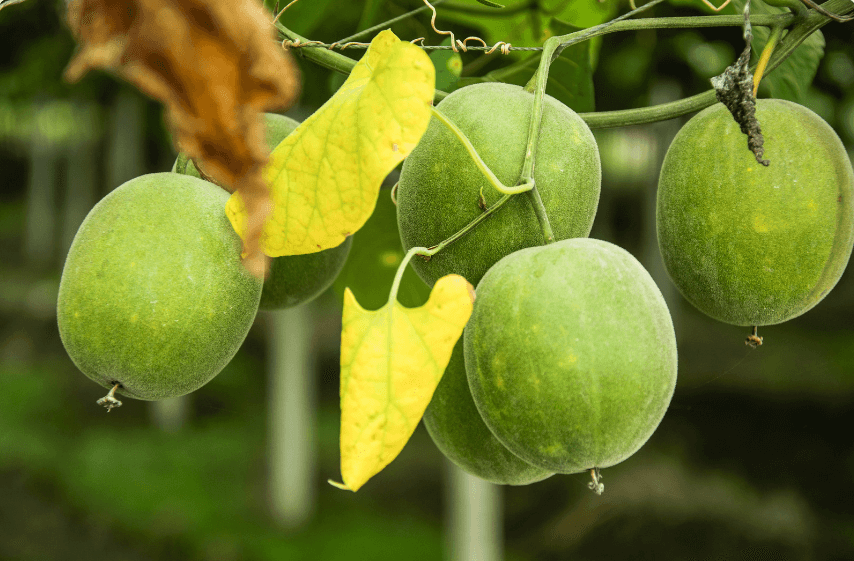
Siraitia grosvenori
Share

Common Name Monk Fruit,Luo Han Guo
Family Name Cucurbitaceae
Parts Used Fruit
Herbal Actions Antioxidant, Anti-inflammatory, Antimicrobial, Anticarcinogenic, Sweetener
Health Benefits Sugar Management, Anti-inflammatory Support, Antioxidant Protection
What are the Benefits of Siraitia grosvenori?
Siraitia grosvenori, commonly known as monk fruit, has been revered for centuries in Traditional Chinese Medicine (TCM) as a healing and nourishing agent for the body.* Energetically, this fruit is considered to be a cooling agent that’s intensely sweet in taste and gentle in application. It’s a vital herb in TCM, routinely used to cool internal heat, relieve throat inflammation, and support respiratory health.
Packed with mogrosides, which are powerful antioxidant compounds, monk fruit offers significant antioxidant benefits, helping to combat oxidative stress and enhance the body’s immune defense.* Recognized for its extraordinary sweetness, which is about 200 times sweeter than sugar but with no calories, monk fruit is often termed a "miracle fruit" for those managing diabetes or wishing to reduce caloric intake.
Its use extends beyond medicinal teas and supplements; monk fruit extract is a popular natural sweetener in various food and drink products, providing a healthy alternative to sugar without affecting blood sugar levels. This versatility makes monk fruit not only a key component in dietary management but also a valued ingredient in modern culinary practices, from beverages to baked goods, contributing to its reputation as a beneficial addition to a healthy lifestyle.
Historical Use of Siraitia grosvenori
Siraitia grosvenori, commonly known as monk fruit, has been deeply embedded in the cultural and medicinal practices of East Asian communities, particularly within traditional Chinese societies. This fruit has not only been utilized for its remarkable health benefits but also has played a significant role in cultural traditions and spiritual practices.
Historically, monk fruit was considered a longevity aid, often used by Chinese herbalists in concoctions aimed at enhancing life span and treating respiratory ailments. Its use was deeply rooted in the belief that it could purify the body and spirit, helping to clear away heat and toxicity from the organs, particularly the lungs and throat.
In spiritual practices, monk fruit was often employed in rituals intended to promote healing and protection. The sweet, healing nature of the fruit was thought to attract positive energy and good health, making it a common offering during health-related ceremonies. Its cooling properties were particularly valued in balancing the body's chi, or vital energy, aligning it with the yin (cooling) aspect of the yin-yang balance necessary for health and wellness.
Monk fruit also found its way into traditional festivities and was used to prepare special ceremonial drinks and dishes that were believed to impart health and vitality to those who consumed them. These preparations were not only a treat due to their sweet nature but also a means of integrating traditional medicinal knowledge into daily life, reflecting the holistic approach to health that is a hallmark of Chinese culture.
This historical significance of Siraitia grosvenori highlights its role beyond mere physical wellness, illustrating its integration into the cultural fabric and spiritual life of the communities that have used it, echoing its status as a cherished and revered fruit.
Botanical Description & Habitat
Siraitia grosvenori, commonly known as monk fruit, is a perennial vine in the Cucurbitaceae family. It is known for its unique, round fruit which is roughly the size of an apple, green when immature, and turns to a brownish color when ripe. The plant's leaves are heart-shaped, 10-20 cm across, and are rough and hairy.
The vine produces small, yellow flowers that are dioecious, meaning male and female flowers are found on separate plants. The fruit itself has a hard, yet thin and smooth exterior. Inside, it contains an edible pulp and numerous seeds encased in a sweet-tasting, fleshy part, which is particularly rich in mogrosides—a type of glycoside that gives the fruit its intense sweetness.
Monk fruit is native to southern China, specifically the regions around the Guilin Mountains, where it has been cultivated for centuries. The plant thrives in moist, shady environments along riverbanks and forest edges. It prefers a humid climate with fertile, well-draining soils but can also tolerate short periods of drought once established.
Due to its specific growing requirements, monk fruit is not extensively cultivated on a global scale and remains mostly grown in its native habitat. The traditional methods of cultivation have been passed down through generations, focusing on sustainable practices that respect the natural ecosystem in which the plant thrives.
In these regions, monk fruit is not only a source of natural sweetener but also an integral part of the local ecosystem, supporting the biodiversity of the area and playing a role in the cultural heritage of the people.
